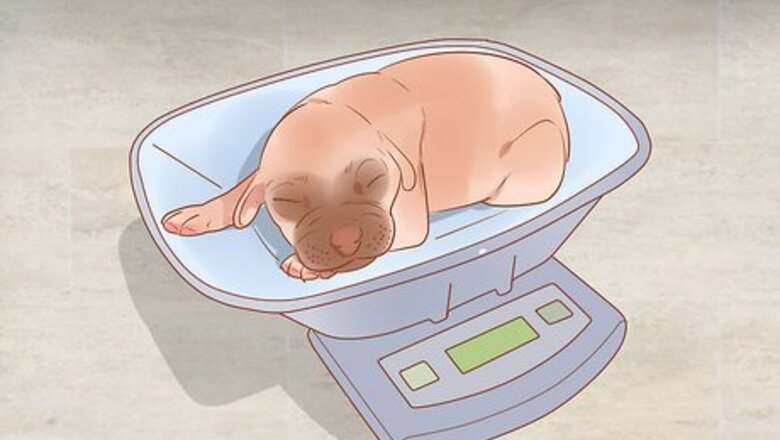
views
X
Expert Source
Colleen Demling-Riley, CPDT-KA, CBCC-KA, CDBCCanine Behavior Consultant
Expert Interview. 25 March 2022.
Interacting with Newborn Pups and Their Mother
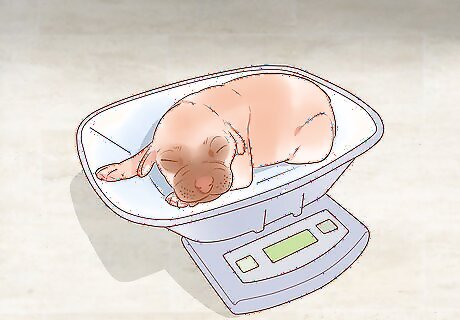
Handle the newborn pups minimally for the first 2 weeks. Weigh the puppies right after delivery and once a day for the first 2 weeks. Other than daily weigh-ins and whelping box maintenance, try to avoid disturbing the litter during these first 2 weeks. As long as they’re healthy and gaining weight, it’s best to interact with them as little as possible right after they’re born. Puppies are fragile, so handling them excessively could pose an injury risk. Disturbing the litter unnecessarily could also stress out the mother. A healthy puppy’s weight should increase about 5 to 10% per day. Call the vet if a pup isn’t gaining weight, cries, or doesn’t huddle up with the rest of the litter. As for their first routine check-up, ask the vet if and when you should take the litter to the office. Puppies are prone to infections, so some vets advise keeping them at home for at least 2 to 4 weeks if there are no signs of trouble.
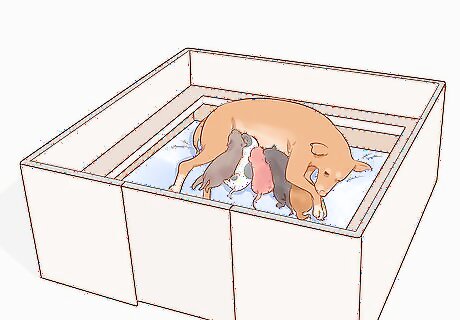
Keep the whelping area calm to help prevent maternal aggression. While the puppies are newborns, only people the mother knows well should approach her and the litter. If you have other pets, keep them away from the whelping area, even if they’re well-behaved. Commotion and unfamiliar people and animals can stress out the mother and lead to aggression. A whelping box is where the dam, or mother, gives birth and the pups spend the first few weeks of their lives.Whelping Box Essentials: Line a shallow crate, cardboard box, or kiddie pool with soft bedding, like newspaper or old towels. Change the bedding when it’s soiled, and place a heating lamp over 1 end of the box to maintain a temperature of 85 °F (29 °C).
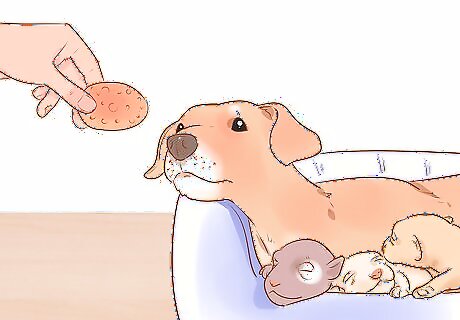
Manage protective aggression with the dam’s favorite treats. If the mother gets aggressive when you try to handle the pups, soothe her in a gentle, encouraging voice. Offer her favorite treats to reward calm behavior and remind her you mean well. If she still won't calm down, have a helper leash her, lead her away for a potty break, and weigh and check the pups while she’s gone. If she excessively growls, barks, tries to bite, refuses to leave the litter, or shows other signs of aggression and you can’t calm her, give her space. If the litter appears healthy, just try again after a few hours or the next day. You can observe the litter from a distance to determine the puppies are latching well and if they cry when they are separated from the litter. If a puppy is not latching well, then you may need to intervene. Dams sometimes aggressively protect their litter, but they usually become calmer after a few days. Keep in mind maternal aggression may mean the whelping area needs to be calmer and quieter.
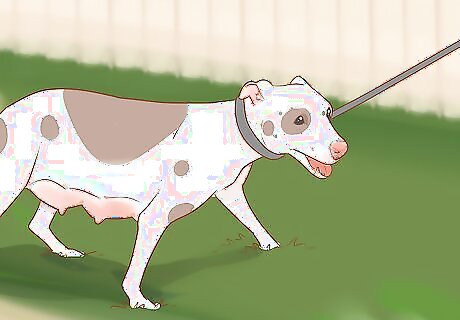
Lead the mother away from the litter for regular potty breaks. Leash the dam and lead her away from the litter every 4 to 6 hours, or according to her normal potty schedule. If she’s hesitant, give a “Come” command and offer a high-value treat. Most of the time, dams periodically leave the litter to stretch, eat, and go potty without hesitation. However, you might have to coax her away during the first few days after giving birth. When she potties, you may notice minor bleeding and a brown or greenish discharge, which are normal for the first week after giving birth. However, call the vet for excessive bleeding and discharge that persists, doesn’t become clearer over time, or smells foul. While the dam is away from the litter, you should also check the teats for redness, swelling, hardness, heat, or tenderness, which are signs of an infection.
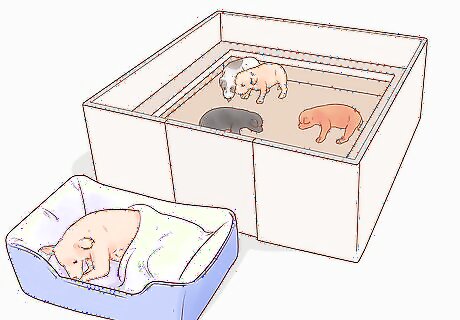
Set up a separate bed for the dam after 2 weeks. Place the mother’s bed next to the whelping box so she has a restful spot where she can keep an eye on the litter. Once the puppies are 2 to 3 weeks old, the mother will start to leave them more frequently and for gradually longer periods. At 2 to 3 weeks old, the puppies will start to crawl, stand, walk, and explore their surroundings. The dam will still want to stay nearby at this stage, but she’ll start leaving them alone to encourage them to become independent.
Weaning the Puppies
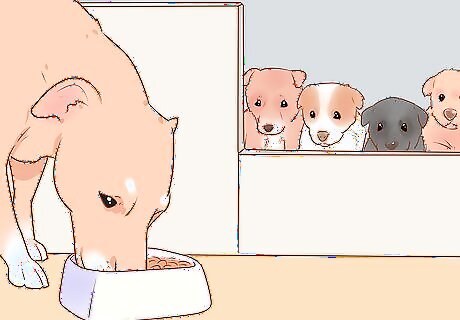
Let the puppies observe their mother while she is eating. Put the mother’s food down when the puppies are nearby so that they can watch her eat. They will be curious and this will also help them to see what they will be eating next. The puppies may even try to copy her!
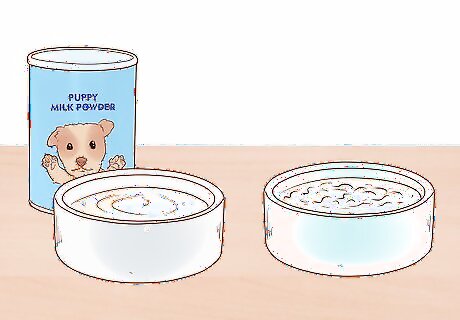
Move from dog milk formula to a blend of soft food and formula. Put milk replacement formula into a few dishes and give this to the puppies before offering them solid food. Once the puppies have the hang of lapping milk, you can mix a little wet food into the milk to make it the consistency of runny oatmeal or soup. Then, gradually thicken the consistency over time until the puppies are eating wet food. You can also mix water or dog milk formula with dry food to soften it.
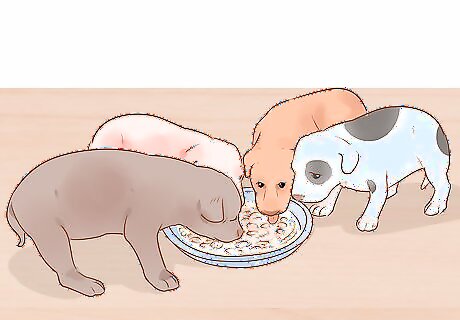
Begin offering warm, soft solid food 3 to 4 weeks after delivery. Blend 12.5 fluid ounces (370 mL) of puppy formula with 2 cups (448 g) of dry puppy food. Next, mix in warm water until you’ve created a consistency like that of baby food or applesauce. Transfer the mixture to a food bowl, then place it in the whelping box. Start by offering 1 meal to the puppies per day to wean them gradually.Tip: To encourage the pups to eat, place them by the bowl, feed them a bit of food by hand, then lower your hand to encourage them to eat from the bowl.
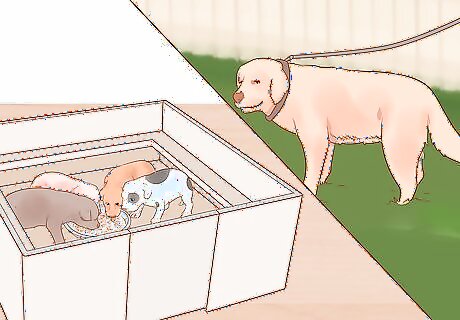
Encourage the dam to leave the litter more often during weaning. Lead the mother away from the litter during meal times so they’ll eat instead of nurse. As the pups become more active, take her out for gradually longer breaks to go potty, play, and spend time with you. Dams often instinctively start weaning by spending more time away from the litter and nursing the puppies less frequently. Follow her lead when you take her for extended breaks. If she wants to return to the litter, let her.
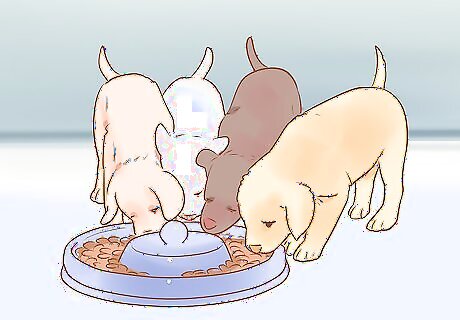
Offer gradually more solid food over the course of a month. By the time the litter is 5 to 6 weeks old, feed them blended formula and dry food 3 times per day. Each week, reduce the amount of milk and water you add so the mixture is gradually thicker and chunkier. By week 8, feed the puppies unmixed, unblended dry puppy food. The right amount of food depends on the puppies’ breed, age, and adult weight, so check your product’s label for recommended serving sizes. Generally, smaller breeds need ½ to 1 cup (112 to 224 g) of food when they’re 2 to 3 months old. Larger breeds typically need around 1 to 2 cups (224 to 448 g).
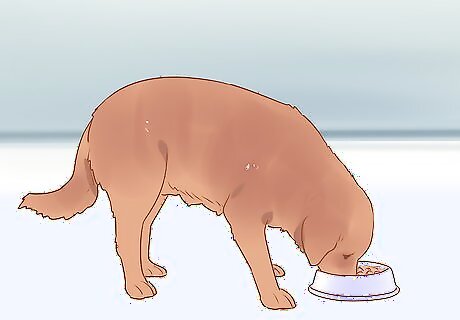
Switch the mother to normal adult dog food gradually. While the puppies are nursing, feed the mother a high-calorie, high-protein commercial puppy food. When you begin the weaning process, replace about 10 to 20% of her daily portion of puppy food with normal adult dog food. Feed her gradually less high-calorie food until her meals consist entirely of normal food by week 8. Feeding the dam puppy food helps maintain her nutrient levels while she produces milk. Abruptly switching her back to normal dog food could make her sick, so it’s important to make the transition gradual.
Socializing the Litter
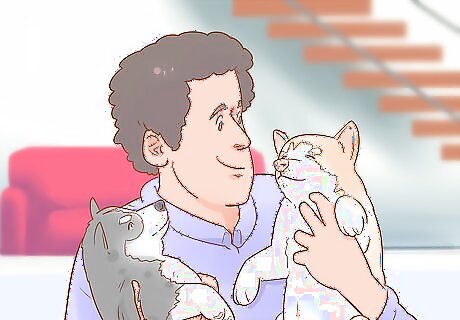
Hold the puppies daily after 3 weeks to get them used to human touch. Pick up the puppies individually and hold them for several minutes at least once a day. Touch each pup’s head, ears, belly, and paws to help it get accustomed to being handled. Other family members and friends should also begin handling the puppies, but you should only introduce 1 or 2 new people at a time. Avoid letting small children handle the pups, as they can be too rough. While dams may be protective soon after delivery, they usually allow other people and animals around the litter by 3 to 5 weeks.
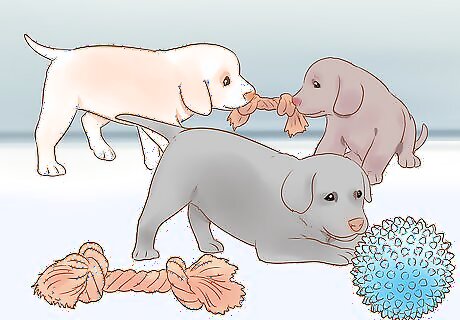
Expose the pups to new surfaces, toys, and environments after 5 weeks. At this stage, the puppies will be active and curious, and they’ll want to explore. Take them out of the whelping box and let them play in penned, puppy-proofed areas. Introduce them to various surfaces, such as carpeted and hard floors, and give them safe dog toys with interesting shapes and textures. Offer plenty of pea-sized treats so the puppies associate new experiences with rewards. Be sure that the treats are tiny to help prevent unhealthy weight gain.Safety Precaution: Supervise the puppies at all times when they’re playing. Additionally, it’s best to keep them inside and away from other animals until they’ve finished their first round of vaccinations.
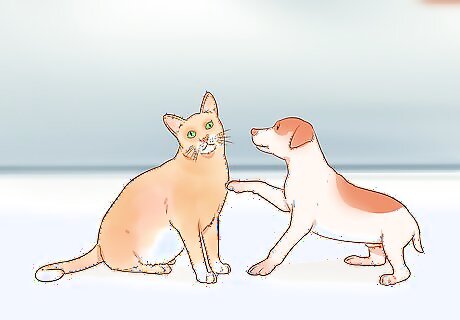
Introduce the puppies to well-behaved animals after they're vaccinated. Typically, puppies finish their first round of vaccinations when they’re around 6 weeks old. Once they’re vaccinated, see if any of your friends, relatives, or neighbors own well-trained dogs. Schedule play dates, and allow your puppies to meet and interact with new furry friends. When you introduce dogs, leash them and allow them to circle each other and sniff. To avoid territorial behavior, it’s best to introduce dogs on neutral turf. Additionally, introduce your puppies to your cat, if you have one, or a loved one’s cat that tolerates being around dogs. When introducing a cats and dogs, a dog should be leashed, and a cat should have an avenue to escape if it feels threatened. If the mother is present when you expose the litter to new animals, make sure she’s leashed, and offer high-value treats to remind her the situation is positive.
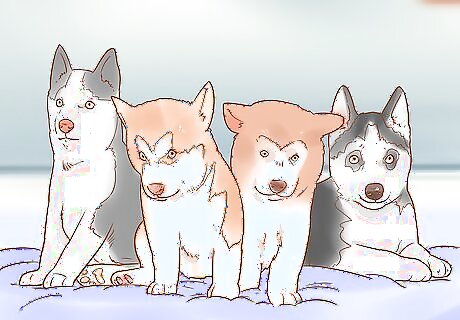
Keep the litter together for a minimum of 8 weeks. If you're rehoming the pups, they’re ready for their new family to adopt them when they're 8 weeks old. As the litter matures, the dam’s maternal instincts start to go away, so she'll also be ready for the puppies to leave the nest. Keeping the puppies with their litter and mother for 8 weeks is a must. Separating puppies prior to 8 weeks can lead to long-term behavioral issues.
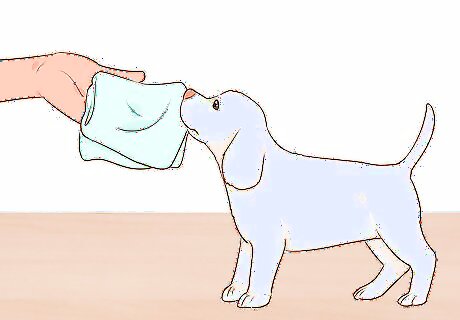
Use familiar scents and pheromones to sooth a pup after separating it. Puppies are highly adaptable, so most adjust to a new home within a couple of days. To help them make the adjustment, give the new family a towel, toy, or other familiar object that carries the litter’s scent. Having a familiar object can make a puppy comfortable with its new surroundings. Artificial pheromones, which you can purchase online and at a vet’s office, are also helpful. These diffusers, sprays, and collars mimic the pheromones a mother dog produces, which can help soothe a puppy after it's left the litter.



















Comments
0 comment